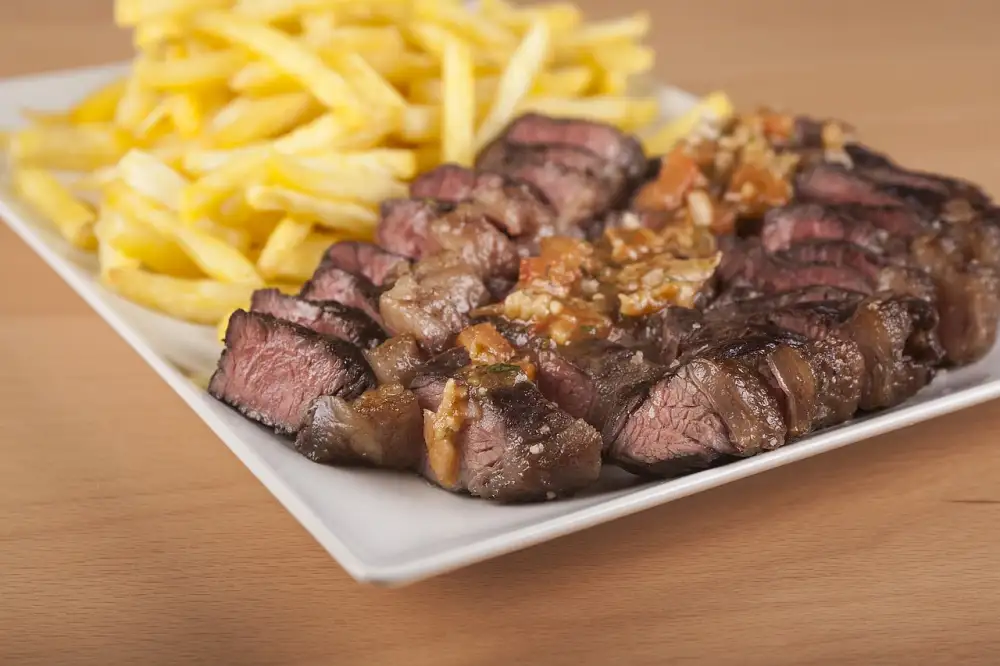Juicy and Flavorful: Exploring the Delights of Rump Steak in Farm to Fork Cuisine

- Understanding the origin: The hindquarter of a cow and the specific muscle used for rump steak
- The unique characteristics of rump steak: Lean, flavorful, and versatile
- Choosing the perfect rump steak: Tips for selecting the best quality and marbling
- Preparing rump steak: Grilling, pan-searing, and other cooking methods for optimal taste
- Pairing rump steak with complementary flavors: Sauces, seasonings, and side dishes
- Health benefits of rump steak: A nutrient-rich choice for protein lovers
- Exploring different regional variations: Popular rump steak dishes from around the world
- Tips for cooking rump steak to perfection: Achieving the desired level of doneness
Rump steak, a beloved beef cut, is known for its incredible flavors and tenderness. It offers a delightful eating experience with every bite. Whether grilled to perfection or pan-seared to create a crispy crust, rump steak never fails to impress. Its succulent texture and rich taste make it a favorite among meat lovers. Join us as we dive into the world of rump steak and discover why it has become such a cherished ingredient in farm-to-fork cuisine.
Understanding the origin: The hindquarter of a cow and the specific muscle used for rump steak
Rump steak comes from the hindquarter of a cow, specifically from the large muscle that sits on top of the animal's rump. This muscle is known for its tenderness and flavor. As the cow moves and exercises this muscle, it develops a rich marbling and deep beefy taste. The rump steak is a popular choice among chefs and food enthusiasts due to its unique texture and taste profile. Understanding the origin of rump steak allows us to appreciate its quality and savor every bite.
The unique characteristics of rump steak: Lean, flavorful, and versatile
Rump steak is known for its unique characteristics that set it apart from other cuts of beef. One of its standout features is its leanness, making it a healthier choice for those watching their fat intake. Despite being lean, rump steak doesn't compromise on flavor. It has a rich, beefy taste that is both robust and satisfying. This makes it a favorite among meat lovers who appreciate bold flavors. Additionally, rump steak is incredibly versatile in the kitchen. Its firm texture allows it to be cooked in various ways, from grilling to pan-searing, ensuring that there's a cooking method to suit every taste preference. Whether you prefer your steak rare or well-done, rump steak can be cooked to perfection while still retaining its tenderness and juiciness.
Choosing the perfect rump steak: Tips for selecting the best quality and marbling
When it comes to choosing the perfect rump steak, there are a few key factors to consider. First and foremost, look for steaks with good marbling. Marbling refers to the small streaks of fat that run through the meat, which not only adds flavor but also helps keep the steak moist and tender during cooking. Opt for steaks with even distribution of fat throughout the meat for maximum juiciness.
Additionally, pay attention to the color of the meat. A bright red color indicates freshness, while a dull or brownish color may suggest that the steak is past its prime. The meat should also feel firm to the touch and have a slightly springy texture.
Another important aspect to consider is the grade of the beef. Higher grades such as Prime or Choice tend to have better marbling and overall quality compared to lower grades like Select. While these higher-grade steaks may come at a higher price point, they often result in a more flavorful and tender dining experience.
Lastly, don't forget about where you're purchasing your rump steak from. Look for reputable sources such as local butcher shops or trusted grocery stores that prioritize quality and freshness. By following these tips, you can ensure that you're selecting a rump steak that will deliver on both taste and tenderness when it's time to cook and enjoy your meal.
Preparing rump steak: Grilling, pan-searing, and other cooking methods for optimal taste
Pairing rump steak with complementary flavors: Sauces, seasonings, and side dishesPairing rump steak with complementary flavors is essential to enhance its natural taste. A classic choice is a rich and creamy peppercorn sauce, which adds a hint of spice without overpowering the meat. For those who prefer a tangy option, a red wine reduction or a balsamic glaze can provide a delicious contrast. Seasonings like garlic, rosemary, and thyme can be used to add depth and aroma to the steak. As for side dishes, roasted vegetables or a fresh green salad make excellent accompaniments, while mashed potatoes or crispy fries provide a satisfying contrast in texture. The key is to choose flavors that complement the beef without overwhelming it, allowing the rump steak to remain the star of the dish.
Health benefits of rump steak: A nutrient-rich choice for protein lovers
Rump steak is not only a flavorful and delicious cut of beef, but it also offers numerous health benefits. Packed with essential nutrients, rump steak is a great choice for protein lovers. It contains high-quality protein that helps in muscle growth and repair. Additionally, rump steak is a good source of iron, which is important for oxygen transport and energy production in the body. It also provides essential vitamins like B12, which supports nerve function and red blood cell production. With its nutrient-rich profile, rump steak is a wholesome option for those looking to maintain a balanced diet while indulging in the delights of farm-to-fork cuisine.
Exploring different regional variations: Popular rump steak dishes from around the world
Rump steak is a versatile cut of beef that is enjoyed in various cuisines around the world. In Argentina, it is known as "bife de chorizo" and is often grilled and served with chimichurri sauce. In Australia, it is a popular choice for barbecues and is seasoned simply with salt and pepper. In France, it is used in classic dishes like steak frites, where it is pan-seared and served with crispy fries. In Brazil, it is called "picanha" and is typically grilled on skewers and served with farofa, a toasted cassava flour mixture. These regional variations showcase the adaptability of rump steak in different culinary traditions, making it a truly global delight.
Tips for cooking rump steak to perfection: Achieving the desired level of doneness
Achieving the perfect level of doneness when cooking rump steak is essential to fully enjoy its flavors and tenderness. Here are some tips to help you cook rump steak to perfection:
- Use a meat thermometer: To ensure accurate cooking, use a meat thermometer to check the internal temperature of the steak. For medium-rare, aim for 135°F (57°C), for medium, aim for 145°F (63°C), and for well-done, aim for 160°F (71°C).
- Rest before slicing: After cooking, allow the rump steak to rest for a few minutes before slicing. This helps retain its juices and ensures a tender and juicy bite.
- Don't overcook: Rump steak is best enjoyed when cooked to medium-rare or medium. Overcooking can result in a tougher texture and loss of flavor.
- Sear it first: Start by searing the rump steak on high heat for a couple of minutes on each side. This will create a flavorful crust while keeping the inside tender.
- Consider thickness: Adjust your cooking time based on the thickness of the rump steak. Thicker cuts may require more time on lower heat to reach the desired doneness.
- Baste with butter or marinade: Enhance the flavor by basting the rump steak with melted butter or your favorite marinade during cooking. This adds moisture and richness to every bite.
By following these tips, you can ensure that your rump steak is cooked to perfection, delivering an unforgettable dining experience with every bite
In conclusion, rump steak is a true delight for meat lovers. Its rich flavor and tenderness make it a popular choice in farm to fork cuisine. Whether grilled, pan-seared, or cooked using other methods, rump steak never fails to impress with its juicy and flavorful taste. Pair it with your favorite sauces, seasonings, and side dishes to enhance the overall dining experience. With its nutrient-rich profile, rump steak is not only delicious but also a healthy choice for protein enthusiasts. So next time you're craving a succulent piece of meat, don't forget to celebrate the freshness and deliciousness of rump steak in every bite!
Published: 02. 12. 2023
Category: Food



